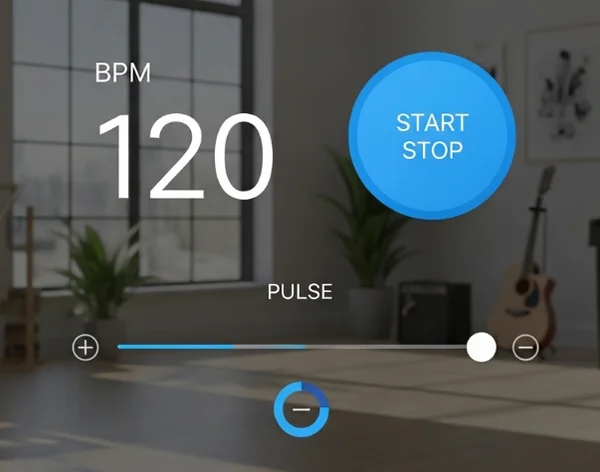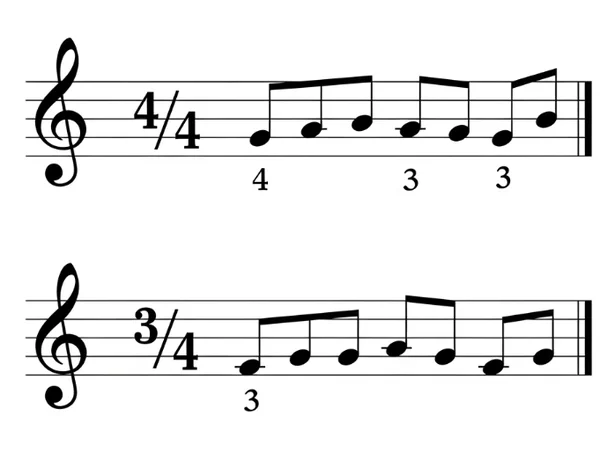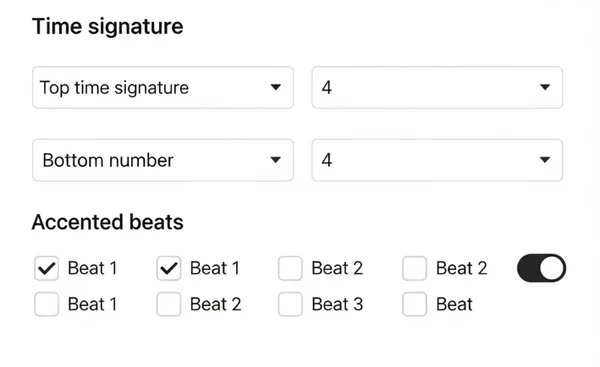Rhythm Fundamentals: Beat, Tempo & Time Signature Explained
Ever felt lost trying to understand the basic building blocks of music? Mastering rhythm fundamentals like beat, tempo, and time signature is crucial for any musician, student, or enthusiast. Concepts like beat, tempo, and time signature can seem complex, but mastering them is key to truly understanding and performing music. Can a metronome improve my rhythm and timing? Absolutely! This guide will demystify these core elements, explaining what they are, how they relate, and how our online metronome tool can help you master them, turning abstract ideas into tangible practice.
Understanding Beat: The Pulse of All Music
The beat is the foundational element of all music, serving as its steady, underlying pulse. Imagine your heartbeat; it's a consistent, recurring sensation. In music, the beat functions similarly, providing a regular, predictable framework around which melodies and harmonies are built. Feeling the beat is the first step towards developing a strong internal rhythm.

What is a Beat? Defining the Rhythmic Pulse
The beat is the simplest, fundamental unit of time in music. It's what you tap your foot to, clap your hands with, or nod your head along with. While rhythm encompasses the entire arrangement of sounds and silences in time, the beat is the constant, driving force. Think of it as the basic tick-tock that keeps everything in motion. Without a clear beat, music would feel chaotic and unstructured.
The Importance of a Steady Beat in Practice
For any musician, maintaining a steady beat is paramount. An inconsistent beat can make a performance sound messy, uncoordinated, and amateurish. Whether you're practicing scales, learning a new piece, or rehearsing with a band, a rock-solid internal sense of beat allows you to play accurately and confidently. It helps synchronize musicians, ensuring everyone stays together and delivers a cohesive sound. Professional musicians spend countless hours honing their ability to internalize and maintain a perfect beat, regardless of the music's complexity.
How Your Metronome Helps You Feel the Beat
This is where your free metronome becomes an indispensable training partner. A metronome provides an audible click or visual cue at regular intervals, precisely marking each beat. By practicing along with it, you train your brain and body to anticipate and internalize this steady pulse. Start by setting a slow tempo and simply playing single notes on each click. Gradually, you’ll find your timing improving, and your ability to maintain a consistent beat will become second nature. Our online metronome offers various customizable sounds to help you feel the beat distinctly.

Decoding Tempo: What is BPM and Why It Matters
Once you understand the beat, the next crucial concept is music tempo. Tempo refers to the speed at which the beats occur. It tells you how fast or slow a piece of music should be played, profoundly influencing its character and emotional impact.
What Does BPM Stand For? (Beats Per Minute Defined)
What does BPM stand for in music? BPM stands for Beats Per Minute. It's the standard unit of measurement for tempo. If a piece of music is marked as 60 BPM, it means there are 60 beats in one minute, or one beat per second. A higher BPM indicates a faster tempo, while a lower BPM signifies a slower tempo. Composers use BPM markings to give performers precise instructions on how quickly to play their music, ensuring their artistic vision is realized. Understanding and accurately setting BPM is fundamental to playing any piece as intended.
Finding the Right Tempo for Your Music & Practice
What is a good BPM for practice? There's no single "good" BPM; it entirely depends on your skill level and the complexity of the music. For beginners, it's always recommended to start slow. Begin with a comfortable, slow tempo (e.g., 40-60 BPM) to ensure accuracy and build muscle memory. Once you can play a section perfectly at a slow speed, gradually increase the BPM. This incremental approach is far more effective than trying to play at full speed from the outset. For existing songs, you might use a tap tempo feature to quickly find its BPM.
Using Our BPM Tool for Precision
Our platform provides a highly intuitive and precise BPM tool. You can easily adjust the beats per minute using a slider, plus/minus buttons, or our unique tap tempo feature. This makes it effortless to experiment with different speeds or quickly pinpoint the tempo of a song you're learning. Whether you need to practice at a very specific speed like a metronome 120 bpm or want to slowly build up from a foundational pace, our platform offers the precision you need for effective practice sessions. Simply visit our homepage and start setting your desired BPM right away.
Time Signatures Demystified: How to Read Music's Rhythmic Map
Beyond the individual beat and its speed, time signature is the blueprint for how beats are organized into larger groups called measures or bars. It tells you how many beats are in each measure and what kind of note gets one beat. Think of it as the rhythmic map that guides you through a piece of music.
Common Time Signatures Explained (e.g., 4/4, 3/4)
A time signature is typically represented by two numbers stacked vertically, like a fraction, at the beginning of a piece of music.
- The top number indicates how many beats are in each measure.
- The bottom number indicates which note value represents one beat (e.g., 4 means a quarter note gets one beat, 8 means an eighth note gets one beat).
Let's look at common examples:
- 4/4 Time (Common Time): This is the most prevalent time signature. It means there are four beats per measure, and a quarter note receives one beat. You'll hear this in most pop, rock, and classical music.
- 3/4 Time (Waltz Time): This means three beats per measure, with the quarter note getting one beat. It creates a flowing, often graceful feel, characteristic of waltzes.
- 2/4 Time: Two beats per measure, quarter note gets one beat. Often used in marches.
- 6/8 Time: Six beats per measure, with an eighth note getting one beat. This often feels like two main beats, each subdivided into three smaller beats, giving it a swinging or rolling feel.
Understanding these notations is crucial for accurately interpreting and playing any musical piece.

The Role of Accents and Beat Subdivision
Within a time signature, certain beats are naturally accented – played with more emphasis – creating a sense of pulse and groove. In 4/4 time, the first beat is usually the strongest, and the third beat has a secondary accent. Understanding these natural accents helps you play with proper musicality.
Beat subdivision refers to dividing a single beat into smaller, equal parts. For example, a quarter note beat can be subdivided into two eighth notes or four sixteenth notes. Practicing with subdivisions helps refine your internal clock and improves your ability to play complex rhythmic patterns accurately. Your metronome can also help you with this by providing sub-divisions, allowing you to hear each eighth or sixteenth note.
Practicing Different Time Signatures with Our Metronome
Our versatile online metronome allows you to customize the time signature metronome settings, making it perfect for practicing various rhythmic structures. You can easily set the top and bottom numbers, and even customize which beats receive an accent. This feature helps you internalize the feel of different meters, from the straightforward 4/4 to more complex time signatures like 5/4 or 7/8. Just adjust the settings on our homepage and choose the specific time signature you need to practice. It’s an invaluable tool for expanding your rhythmic vocabulary.

Your Journey to Rhythmic Mastery Begins Here
Building a strong foundation in rhythm fundamentals—understanding beat, tempo, and time signature—is transformative for any musician. These concepts, once grasped, unlock your ability to play with precision and truly express the soul of the music. Consistent practice with the right tools makes these abstract ideas tangible, propelling your musical proficiency. Our site is designed to be your ultimate online metronome resource, providing a powerful, accurate, and completely free tool to support your rhythmic development. Whether you're a diligent music student, a professional musician, or a rhythm-based performer, our customizable platform offers everything you need to improve your timing and confidence. Ready to transform your practice? Start your rhythmic journey with us today.
Frequently Asked Questions About Rhythm Fundamentals
What is the main difference between beat and rhythm?
The beat is the steady, underlying pulse of music—like a ticking clock. Rhythm, on the other hand, is the arrangement of sounds and silences in time, creating patterns on top of that steady beat. Think of the beat as the foundation and rhythm as the unique architectural design built upon it. Our online metronome helps you feel the beat, allowing you to then build complex rhythms.
How do I find the tempo of a song if I don't know the BPM?
You can find the tempo of a song by using the Tap Tempo feature on our metronome online tool. Simply listen to the song and tap along to the beat on your keyboard or screen. Our tool will automatically calculate the average BPM based on your taps, giving you an accurate starting point for practice. It's an incredibly useful BPM tool for quick tempo identification.
Can a metronome really improve my rhythm and timing?
Absolutely! A metronome is truly one of the most effective tools for improving rhythm skills and timing. It provides an objective, unwavering external pulse, forcing you to synchronize your playing precisely. Consistent practice with an online metronome trains your internal clock, helping you develop better consistency, accuracy, and an overall stronger sense of timing.
What is a "good" BPM for beginner practice sessions?
For beginners, a "good" BPM is one that allows you to play accurately and without tension. Generally, starting between 40-60 BPM is recommended, especially when learning new material. The goal is perfect accuracy at a slow tempo. Once you can play a section flawlessly at a slow speed, gradually increase the BPM by 5-10 increments until you reach the desired pace. Remember, slow practice is fast progress! You can easily adjust the tempo on our free online metronome to find your ideal practice speed.